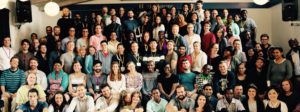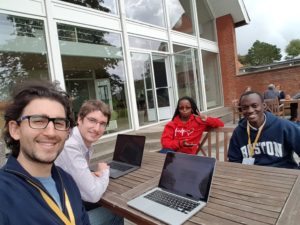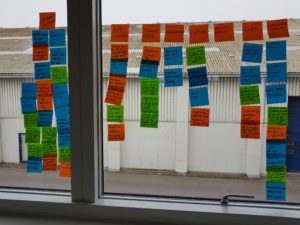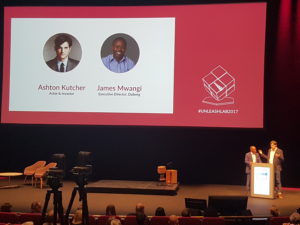I have just returned from Denmark as a participant in the first UNLEASH innovation lab. The purpose of the nine-day event was to create real, scalable solutions to the Sustainable Development Goals. Here is a link to an article I wrote prior to attending: A Nudge Towards Achieving the Sustainable Development Goals (SDG).
The massive event brought together 1,000 people from 130 countries. We spent the first two days in Copenhagen hearing inspirational talks from people such as Aric Dromi, Futurologist at Volvo, and understanding what the Sustainable Development Goals are all about.
We then divided into groups of about 100-150 people under different SDG themes, and travelled to different folk highschools around the country. My Energy theme group travelled 4 hours west by bus to Vestjyllands Højskole. The adult students who normally come to live and learn at this school enrol in courses about dance, music, theatre, painting, ceramics. and sustainability. We were here to come up with energy solutions.
The school was absolutely beautiful. First, and fittingly given our goals, the school was powered by a nearby wind turbine and solar panels. The food was promised to be the best of any school in the land – and they were not kidding. Perhaps the magic came from the fact that most of the ingredients for our meals were sourced from the school’s own beautiful garden. The garden is hard to describe but it was so well laid out and included a memorable rock maze and fire pit. Each morning began with tasty breakfast, singing (John Lennon’s “Imagine” was a stand-out for me), and a philosophy lecture. It felt a bit like what every morning should start like.
Guided by some excellent facilitators from Deloitte, we were again divided into areas of interest. I was appropriately placed into the Consumer Behaviour group, which included about 20 talents. After spending half a day exploring different barriers and problems to achieving the Energy SDG, we were allocated into teams. I was placed in a team with Siegfried King, an engineer from Chile, Chebet Lesan, a designer from Kenya, and Leroy Mwasaru, a budding entrepreneur from Kenya.
For the next four days we worked intensively together following the Deloitte innovation process: Problem Framing –> Ideation –> Prototyping –> Testing –> Implementing. Each stage was associated with with a number of exercises designed to help us think deeper about the problem and move closer towards a solution. Our deliverables were a 3-minute pitch and a written submission including the following sections:
- Executive summary: Overview of your solution
- Problem: What is the global challenge that you are addressing? What unique, actionable insights led you to this specific problem framing?
- Solution: What is your solution and how does it address the problem framing?
- User / customer: Who are your users or customers? What are their needs? What is the value proposition that your solution offers? How big is the market?
- Innovation: What makes your solution unique? Who are your competitors? Why hasn’t your solution been done or successfully implemented before?
- Traction: What is your progress to date? How many users / customers have you spoken to or have adopted your solution? What is your implementation strategy?
- Impact: What is the impact that you are creating? What SDG indicators can be used to measure if your solution is successful?
- Financials: How are you going to fund your solution? What is your financial model? What is your financial ask?
- Team: Who is on your team and what are their skills? What skills are you missing on your team?
- Next steps: What is your plan of action after UNLEASH?
My team initially decided to focus on food; specifically, how could we reduced people’s red meat consumption. We explored the problem from all angles. We realised that it was a really hard problem. Adult’s preference for meat was pretty much set. Therefore, we decided to focus on children, whose preferences were somewhat more labile. We decided that a game encouraging more environmentally healthy foods might be a viable approach. It was at about this point that we decided none of us was passionate about building a children’s game. That’s not to say it isn’t a great idea. I still think it is. It just wasn’t a good solution for our team to pursue.
Two days in, my team restarted the innovation process. This time we decided to focus on encouraging people to purchase more fuel efficient cars. Our research revealed how unimportant fuel economy was in the purchase decision. Much more important were things like aesthetic appeal and prestige. We decided to capitalize on this by proposing a website that would allow you to find your perfect car while using behavioural economics to nudge users way from the fuel-inefficient cars. The unique feature of our proposed website included information about each cars’s aesthetic appeal and prestige, and social media integration to immediately poll your friends on different cars in your selection set. You can read our submission here.
The 1,000 talents reconvened in Aarhus, the second-largest city in Denmark and the 2017 European Capital of Culture. Without much sleep, each team presented its pitch to the others in their theme. Through a peer evaluation process scored on innovation, potential impact, viability, and presentation, the herd was thinned. Unfortunately, my team was not selected to move onto the next round but I think Leroy and I did a great job. During the second round, surviving teams pitched again, this time to a panel of experts who grilled them on all aspects of the proposed solution. Finally, the the panel decided on the top two pitches to move through to the final, which would take place in front of everyone.
The pitches were all very impressive. It’s amazing what a team of passionate, motivated strangers can do in less than a week when you lock them in a room together and give them support. You can see the list of winners – one from each theme – here. I think my favourite was team “Block Fakes”, which proposed using blockchain technology for tracking the movement of drugs along the supply chain, so that patients benefit by having a verifiable record of their drug’s provenance through an app.
The final day included meetings with prospective investors and concluded with the UNLEASH awards show. The show included fantastic and inspirational speeches by several people including Princess Mary of Denmark, Prime Minister of Denmark Lars Løkke Rasmussen, Founder and CEO of Khan Academy Salman Khan, and actor (and investor!) Ashton Kutcher.
So what did UNLEASH, which I understand cost several million dollars to run, achieve? Personally, I met some brilliant, interesting people from a diverse range of fields and countries. I am sure that I will meet many of these people again (in fact, I already have). I have also had my eyes open to bigger problems in society; problems beyond the narrow focus that academia tends to push professors into through the pursuit of publication success. Although my team’s specific idea did not get funded (even though I think it is a great idea). I now have a stronger sense of how new (and existing) companies can be profitable while also having a net positive impact on the world.
More generally, many ambitious ideas were generated by the innovation lab, several of which have already been funded and are starting to build steam. Only time will tell what their impact will be. Ultimately, you cannot succeed if you do not try to.
The ongoing plan for UNLEASH to re-occur every year until 2030 when everyone will reconvene in New York. Between now and then I look forward to continuing to contribute to solutions addressing the SDGs in my own way. If there’s anything that this experience has helped me learn it is that there is hope; these goals are achievable. We just need to get out there and do it.




